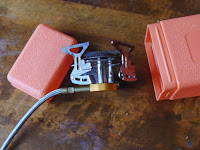I've been doing some research on small washing machines suitable for offgrid living. Mostly because my current setup happens outdoors and about once a month I spend nearly a full day doing 4 or 5 loads of washing. It comes out super clean, and runs much easier now that I use an electric pump to raise the water out of the well and have the bath tub as a reservoir or for soaking.
But it's a hard way of life when it's cold, and ideally I'd like to be able to do small loads indoors. Not so easy when there's no plumbing other than one drain from the kitchen sink.
So here's what I've come up with so far: I'd be very happy to hear about experiences with any of these or other options. Next step is working out which of these are available in Sweden.

The Drumi : http://www.yirego.com/
Foot powered mini-washer that works with a bucket of water. This isn't available yet, but it looks like it will be out in spring or summer 2018. $239 plus shipping (and no doubt import duty) from the Yirego, it also has an Indigogo page. It uses 5-10 litres of water and does a minoload in 5 minutes. Compatible with watching a film, I think, maybe even catching up with email and facebook.

The Laundry Pod:
http://www.storebound.com/laundrypod/shop/laundry-pod
Cheaper ($99 plus shipping etc), this is hand cranked. So it looks like it could work in my kitchen on the sink. On the other hand I think I'd rather pay the extra to do the washing with stronger muscles and sitting down.
I've also seen links and reviews of these three, but I can't see them for sale:
Venus - Electric handheld whizzer that does the washing in a bucket with a 5 min cycle. There's a web form for enquiries. This could be a quite a cute option for a camper van or a caravan if it runs OK off an inverter.
Petit Swoosh - Another electric washer, but in a counter-top format. Five mins and 5 litres. From Japan, it looks like this might be on the market later this year at around $150. Or maybe not.
Giradora - One of the original new human-powered washers, and designed for the 3rd world.
I've also seen various ideas for do-it-yourself versions, often involving one or more buckets and a plunger. Like this or this two bucket version for eg. Or an even simpler one here.
There was also this easy to make design, which looks like it has some potential, but looks like it is probably a bit fussy to use.
Finally - a video showing a bicycle linked to a normal washing machine. I'd love to hear more about any designs like this.
But it's a hard way of life when it's cold, and ideally I'd like to be able to do small loads indoors. Not so easy when there's no plumbing other than one drain from the kitchen sink.
So here's what I've come up with so far: I'd be very happy to hear about experiences with any of these or other options. Next step is working out which of these are available in Sweden.

The Drumi : http://www.yirego.com/
Foot powered mini-washer that works with a bucket of water. This isn't available yet, but it looks like it will be out in spring or summer 2018. $239 plus shipping (and no doubt import duty) from the Yirego, it also has an Indigogo page. It uses 5-10 litres of water and does a minoload in 5 minutes. Compatible with watching a film, I think, maybe even catching up with email and facebook.

The Laundry Pod:
http://www.storebound.com/laundrypod/shop/laundry-pod
Cheaper ($99 plus shipping etc), this is hand cranked. So it looks like it could work in my kitchen on the sink. On the other hand I think I'd rather pay the extra to do the washing with stronger muscles and sitting down.
I've also seen links and reviews of these three, but I can't see them for sale:
Venus - Electric handheld whizzer that does the washing in a bucket with a 5 min cycle. There's a web form for enquiries. This could be a quite a cute option for a camper van or a caravan if it runs OK off an inverter.
Petit Swoosh - Another electric washer, but in a counter-top format. Five mins and 5 litres. From Japan, it looks like this might be on the market later this year at around $150. Or maybe not.
Giradora - One of the original new human-powered washers, and designed for the 3rd world.
I've also seen various ideas for do-it-yourself versions, often involving one or more buckets and a plunger. Like this or this two bucket version for eg. Or an even simpler one here.
There was also this easy to make design, which looks like it has some potential, but looks like it is probably a bit fussy to use.
Finally - a video showing a bicycle linked to a normal washing machine. I'd love to hear more about any designs like this.









